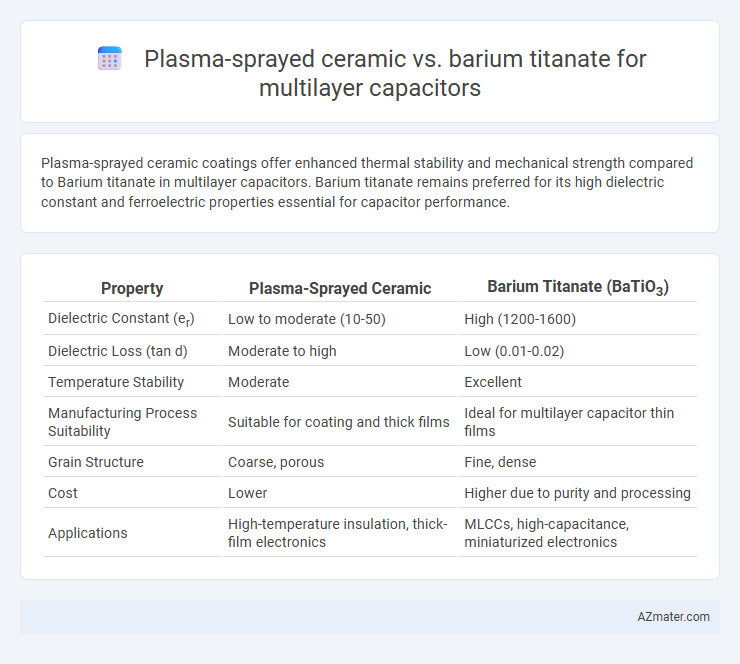Plasma-sprayed ceramic coatings offer enhanced thermal stability and mechanical strength compared to Barium titanate in multilayer capacitors. Barium titanate remains preferred for its high dielectric constant and ferroelectric properties essential for capacitor performance.
Table of Comparison
| Property | Plasma-Sprayed Ceramic | Barium Titanate (BaTiO3) |
|---|---|---|
| Dielectric Constant (er) | Low to moderate (10-50) | High (1200-1600) |
| Dielectric Loss (tan d) | Moderate to high | Low (0.01-0.02) |
| Temperature Stability | Moderate | Excellent |
| Manufacturing Process Suitability | Suitable for coating and thick films | Ideal for multilayer capacitor thin films |
| Grain Structure | Coarse, porous | Fine, dense |
| Cost | Lower | Higher due to purity and processing |
| Applications | High-temperature insulation, thick-film electronics | MLCCs, high-capacitance, miniaturized electronics |
Introduction to Multilayer Capacitors
Multilayer capacitors (MLCs) are essential components in electronic circuits, offering high capacitance in a compact form through alternating layers of dielectric and electrode materials. Plasma-sprayed ceramic coatings enable precise control of dielectric thickness and uniformity, enhancing performance and reliability in MLC fabrication. Barium titanate remains a widely used ceramic dielectric due to its high permittivity and temperature stability, making it a critical material for achieving high capacitance in multilayer capacitor designs.
Overview of Plasma-Sprayed Ceramic Materials
Plasma-sprayed ceramic materials provide high thermal stability and mechanical strength, making them ideal for multilayer capacitor substrates. These ceramics offer controlled microstructures with low porosity and excellent dielectric properties, enhancing capacitor reliability and performance. Compared to barium titanate, plasma-sprayed ceramics enable flexibility in coating thickness and composition, supporting advanced capacitor designs with improved breakdown voltage and insulation resistance.
Properties of Barium Titanate in Capacitor Applications
Barium titanate exhibits high dielectric constant and excellent temperature stability, making it ideal for multilayer capacitor applications requiring high capacitance in compact sizes. Its ferroelectric properties contribute to low dielectric loss and reliable performance under varying electrical conditions. Compared to plasma-sprayed ceramics, barium titanate offers superior electrical insulation and enhanced energy storage capabilities essential for efficient capacitor operation.
Dielectric Performance Comparison
Plasma-sprayed ceramic coatings exhibit enhanced dielectric breakdown strength and thermal stability compared to bulk Barium titanate (BaTiO3) used in multilayer capacitors (MLCs), resulting in improved reliability under high voltage stress. While BaTiO3 offers high permittivity critical for capacitor capacitance, plasma-sprayed ceramic layers provide superior microstructural control that reduces dielectric losses and enhances insulation resistance at elevated temperatures. The tailored microstructure of plasma-sprayed ceramics enables better performance consistency in demanding applications where BaTiO3-based MLCs may suffer from aging and degradation.
Fabrication Techniques: Plasma Spraying vs Conventional Methods
Plasma-sprayed ceramic coatings enable rapid deposition of dense, uniform layers with excellent adhesion for multilayer capacitors, offering superior control over microstructure compared to conventional sintering and tape-casting methods used with barium titanate. Plasma spraying provides enhanced flexibility in layer thickness and composition tuning, while traditional fabrication of barium titanate relies on powder processing, pressing, and high-temperature sintering to achieve desired dielectric properties. The thermal dynamics and deposition kinetics of plasma spraying reduce grain growth and porosity, potentially improving capacitor performance and reliability over conventionally fabricated barium titanate multilayers.
Thermal Stability and Reliability
Plasma-sprayed ceramic coatings exhibit enhanced thermal stability in multilayer capacitors by maintaining dielectric properties at elevated temperatures, outperforming barium titanate which tends to degrade due to phase transitions and increased dielectric loss. The microstructural control in plasma-sprayed ceramics reduces thermal stresses and enhances reliability under cyclic thermal loading, critical for high-temperature capacitor applications. Barium titanate's reliability diminishes at temperatures above 125degC, whereas plasma-sprayed ceramics sustain stable permittivity and low leakage currents, ensuring longer operational lifespans.
Cost Analysis and Economic Considerations
Plasma-sprayed ceramic coatings often present higher initial manufacturing costs due to complex equipment and energy-intensive processes compared to barium titanate, a widely used dielectric material known for its cost-effectiveness and scalability in multilayer capacitors (MLCs). Economic considerations favor barium titanate as it combines excellent dielectric properties with mature production techniques, enabling lower unit costs and mass production efficiency. However, plasma-sprayed ceramics may justify their higher cost in niche applications requiring enhanced thermal stability or mechanical robustness, where performance gains outweigh the expense.
Microstructural Differences and Effects
Plasma-sprayed ceramic coatings in multilayer capacitors typically exhibit a porous microstructure with larger grain sizes, leading to lower dielectric constant and increased dielectric loss compared to Barium titanate, which possesses a dense, fine-grained microstructure that enhances dielectric permittivity and stability. The microstructural differences directly influence the capacitive properties, where the uniform grain boundaries in Barium titanate facilitate higher polarization and energy storage capabilities. Consequently, Barium titanate multilayer capacitors demonstrate superior performance metrics, including higher capacitance density and improved reliability under thermal and electrical stress.
Long-term Durability and Aging Effects
Plasma-sprayed ceramic coatings exhibit superior long-term durability in multilayer capacitors due to enhanced structural integrity and resistance to thermal cycling compared to barium titanate, which suffers from gradual degradation under repeated electrical stress and temperature variations. Barium titanate's aging effects include decreased dielectric constant and increased leakage current over time, impacting capacitance stability and device lifespan. Plasma-sprayed ceramics minimize these aging phenomena by maintaining stable microstructures and reducing defect formation at grain boundaries, thereby improving reliability in high-performance capacitor applications.
Application Suitability and Future Prospects
Plasma-sprayed ceramics offer robust thermal stability and mechanical strength ideal for high-voltage multilayer capacitors required in power electronics and automotive sectors. Barium titanate provides superior dielectric properties and high permittivity, making it more suitable for miniaturized capacitors in consumer electronics and memory devices. Future trends indicate increasing integration of barium titanate with advanced manufacturing techniques to enhance energy density, while plasma-sprayed ceramics are poised for development in harsh-environment applications demanding durability and thermal resistance.

Infographic: Plasma-sprayed ceramic vs Barium titanate for Multilayer capacitor
 azmater.com
azmater.com